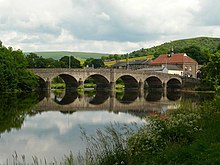Builth Wells
Builth Wells
|
|
|---|---|
 Bridge over the River Wye at Builth Wells |
|
| Builth Wells shown within Powys | |
| Population | 2,568 (2011) |
| OS grid reference | SO035505 |
| Community |
|
| Principal area | |
| Ceremonial county | |
| Country | Wales |
| Sovereign state | United Kingdom |
| Post town | BUILTH WELLS |
| Postcode district | LD2 |
| Dialling code | 01982 |
| Police | Dyfed-Powys |
| Fire | Mid and West Wales |
| Ambulance | Welsh |
| EU Parliament | Wales |
| UK Parliament | |
Builth Wells (/ˈbɪlθ ˈwɛlz/; Welsh: Llanfair ym Muallt) is a town and electoral ward in the county of Powys, within the historic boundaries of Brecknockshire, mid Wales, lying at the confluence of the River Wye and the River Irfon, in the Welsh (or Upper) section of the Wye Valley. It has a population of 2,568, or 2,994 including the neighbouring village of Llanelwedd in Radnorshire.
Builth is an anglicization of the Welsh Buellt or Buallt. It derives from the Welsh words bu, meaning "ox", and gellt (later gwellt), meaning "pasture", rendering "cow pasture". The town added "Wells" to the name in the 19th century when its springs were promoted as a visitor attraction. The Welsh name Llanfair-ym-Muallt means "St Mary's Church in Buallt".
Builth first emerged in post-Roman times, probably on the other side of the Irfon river from its present site at Dol Eglwys (Church Mound) where a ruined early medieval church is thought to have stood. Vortigern, the British ruler alleged to have invited the Saxons to Britain is sometimes said to have owned land in nearby Builth Road on the Radnorshire side of the River Wye; the site previously having been known as Cwrt Llechrhyd. Early Post-Roman Builth was an independent kingdom. The most famous ruler was Elystan Glodrydd from whom many local gentry claimed descent. As an important component of Rhwng Gwy a Hafren, a political entity referred to in the poems of Taliesin, Builth was regularly at war with the Kingdom of Powys. Ecclesiastically, the Deanery of Builth has always been part of St Davids / later Swansea and Brecon, rather than St Asaph, the Powys diocese. Glodrydd probably lived at Llanafan Fawr rather than the modern site of Builth Wells. Until the foundation of the Norman town Llanfair ym Muallt the main settlement was Llanafan. Stories about Philip de Braose centre on Llanafan not modern Builth.
...
Wikipedia

